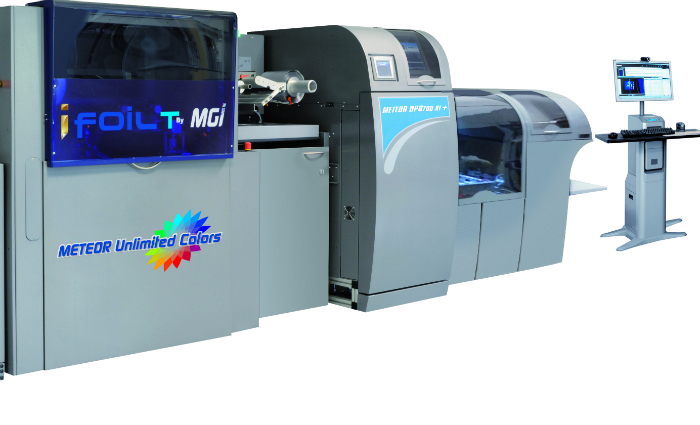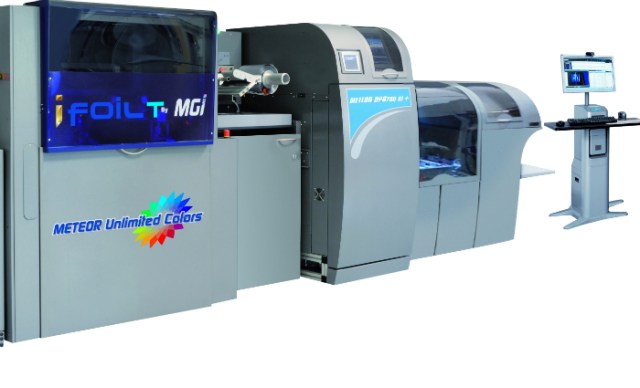
MGI Unlimited Colors
What does it do?
Unlimited Colors is an inline digital hot foiling system introduced for the French manufacturer MGI’s Meteor DP series of dry toner digital presses. It comprises the new iFoil T foiling unit that can be fitted to new presses, or retrofitted.
The Unlimited Colors name refers to the fact that hot foil is not just available in metallic and holographic materials, but a wide range of spot colours and effects. The press can overprint onto the foil as a second pass, and create digital holographic effects.
Here we are considering the complete package of the Meteor DP 8700XL press with the inline foil unit ready-fitted. This five-year-old mid-production press is based on a Konica Minolta dry toner four-colour duplex print engine, modified for thicker and longer media including plastics.
The XL+ has an offset-style pile feeder that can take very long sheets up to 1,200mm long. Unlimited Colours is also available on the DP8700S+650, which doesn’t have the pile feeder and is popular for envelope printing. It will also be optional with the forthcoming Meteor DP 1000XL, which uses the latest Konica Minolta engines.
MGI is supplied in Australia by Konica Minolta, which owns the company.
In future the foiling unit will also come as a standalone with a feeder and stacker.
When was it launched?
Unlimited Colours was announced at drupa 2016 as an option for Meteor presses. The iFoil T unit is adapted from the iFoil system used with MGI’s JetVarnish 3D clear UV spot varnish inkjets.
How does it work?
The iFoil T takes ribbons of standard hot foil from any supplier. It incorporates a foil roll feeder and waste takeup, with a heated application roller.
First the press prints a black-only image where foil is required. As the sheet passes through the foiler, the heated roller and the foil ribbon are pressed against it. The black toner absorbs heat, activating adhesive on the foil, which transfers to the image. Paper or plastic media reflects heat so the adhesive isn’t activated.
The application roller is ‘indexed,’ so it can be raised and lowered as the sheet passes underneath. Different widths of foil ribbon can be used, while two different ribbons can fit across the width. Like any digital press every copy can be different.
It might be possible to print a four-colour image with black-only areas that would pick up the foil. In most cases it would be simpler to run two passes: black-only for the foil, and then manually reloading for a full-colour pass, which gives the possibility of overprinting the foil. MGI’s new AIS SmartScanner camera-based registration compensates the ripped image for any size changes on the second pass.
How does it differ from previous models?
Meteor presses are modified to fit the foiling unit between the press output slot and the delivery stacker. The EFI Fiery front end software is also modified to control the foiler and registration of second passes.
How fast/productive is it?
The foiling unit runs up to 50 A4spm. This is a nominal speed as it depends on the indexing and length of foil per copy. The press is slowed to match it, but full speed can be used for the second print-only pass.
What is the USP?
It appears to be the first digital foiling unit to run inline with a press and use the same rip and press controls.
How easy is it to use?
The foiling unit is controlled from the Meteor front end, so using it is pretty straightforward. A specially named spot colour is created in a design program, overlaid over the main image. This is detected by the Meteor DFE and used to print the black pass, and to trigger the indexing roller in the foil unit.
How much does it cost
Unusually, there’s no click cost so you just pay for consumables plus a support package. ProPrint understands a DP8700XL with Unlimited Colors would cost just over $500,000, about $180,000 more than the standard press. Upgrades to existing installations will cost a bit more because the press will need to be adapted.
SPECIFICATIONS
DP 8700XL+ press
Speed up to 4,260 A4 pages/hour or 2,280 A3 pages/hour
Maximum print area 330×1,200mm
Paper /card sizes From 100x148mm, to 330×1,200mm
Resolution 3,600dpi and 270lpi
Feeder 3,000 sheet pile for sheets up to 330×1,200mm unit plus 2x 1,500 sheet paper drawers for sheets up to 330x487mm
Substrates Paper, plastic, polycarbonate, vinyl and PET substrates, envelopes
iFoil T
Media thickness without overprinting 80 to 350gsm
Media thickness with overprinting 150 to 350gsm
Speed Up to 50 A4sheets/min
Foil roll sizes Up to 100 to 320mm wide and 400m long
ALTERNATIVES
As far we know the MGI is the only digital foiling unit able to be integrated with a digital press via a single control unit. But drupa saw some sophisticated standalone systems launch onto the market, including those from foil supplier Kurz and digital enhancement systems developer Scodix
German foil maker Kurz launched a pair of printers for high throughput foiling. It calls the process Digital Metal (DM). Its original DM Liner applies heat-activated hot foil to sheets printed with black dry toner or Indigo ElectroInk. The sheets can then be overprinted in a separate press.
The new DM-Liner UV Ink bypasses the pre-print stage. It is a standalone B2 digital inkjet (max width 324mm) that applies UV ink to sheets and foil onto that before curing with an LED lamp. DM-Liner UV Ink produces up to 3,600 SRA3 sheets per hour. It can foil black sheets that can then be overprinted, or over pre-printed sheets with auto optical registration.
Essentially it is a foiling process that combines digital printing with a coating- and metal-transfer process to create metallised surfaces. The process is relatively simple. It involves printing a black layer on a digital press then running the sheets through a DM-Liner Digital Foil machine, which heats up the black layer and laminates it together with the foil. After detaching the carrier film, the sheet can then go back in the digital press to be over-printed with CMYK. The over-print creates metallic colours to offer a kaleidoscope of tints. The foils used are silver, gold, diffraction (for an iridescent look) or holographic.
Kurz says there are myriad applications including short run labels, packaging, brochures, invitations, greetings cards and mock-ups. According to the company it allows huge creative leeway, with classy gold, silver, iridescent effects or holograms in digital printing, high gloss, many different metal colour shades from excellent overprinting properties, full-shade and half-shade effects, enhancement of fine, delicate designs, single surfaces and cut-outs, full-surface decoration of large surfaces, enhancements that are edge-sharp and only on specified areas, and a pure white remains pure white after enhancement, without haziness.
The DM-LINER allows a digital transfer of metallisations onto paper and cardboard stock. The transfer process is upstream of the digital colour printing. The designs to be metallised are first printed with toner or electro- ink; then, the Digital Metal foil is transferred by the DM-Liner and the PET carrier is removed. For processing, the DM-Liner can be supplied by sheets as well as rolls. The addition of an unstacker and stacker allows the basic machine to be used for digital sheet-fed printing.
The DM-LINER UV-INK digitally transfers metallisation onto paper and cardboard. The transfer process can be upstream or downstream of the colour printing. The designs to be metallised are first printed with UV-ink. The metallisation is then transfered to the substrate and hardened with an LED UV. The carrier foil is removed after the transfer procedure. The addition of a destacker and stacker allows the basic machine to be used for digital sheet-fed printing.
Other standalone systems include MGI’s own Jetvarnish clear UV varnish inkjet with iFoil unit (B1 to B3).
Scodix has a similar unit for its clear varnish inkjets, from B1 to B2. Scodix Foil Station is an optional module, that runs in-line with the Scodix Ultra Pro Digital Press, delivering foil enhancement capabilities, including high gloss, embossed, variety of densities for short to medium runs, using a highly advanced, highly-efficient digital process. Scodix Foil is ideal for commercial printers, coping with short to medium runs, who today have to outsource the foil application or to use a long and expensive make ready process including molds and dies, as well as for converters doing high-end short up to medium runs.
Scodix Foil deploys a wide range of hot and cold industry standard foil films, coupled with a variety of substrates, including offset, digital, plastics, laminated/non-laminated, and coated/ Without coating Applications include business/greeting cards, folders, book covers, brochures, labels, packaging and more.
Based on the proprietary Scodix Ultra Pro platform, Scodix Foil provides a host of innovative, patented technologies: RSP (Rotate Scale Position) – based on 4 CCD cameras and sophisticated algorithms for optimal image to image registration, PAS (Pin Activate Secure) –a patented foil process using the PolySense 500 polymer to enable ultra-fine details with wide variety of foils on ranges of substrates, Transfer capabilities – achieved in conjunction with Compact brand foilers, the market leader in foil transfer units; synergy between the companies results in robust, high-yield production with significant foil savings
Scodix says the whole process is cost effective – by replacing the conventional analogue method, eliminating the need for dies, plates, molds and other costly materials, providing what it says are incomparable cost-savings for short to medium runs. Scodix says its patented technologies, the PAS, RSP and transfer process deliver superior foil enhancement print with ultra-fine details, high gloss, surface coverage and flawless registration; it says high-end print quality is achieved via a robust and reliable automatic process with a high production yield. It also allows VDP/VDE capabilities that enable personalisation with foil.
In other alternatives Mimaki has its UJF small UV inkjet flatbeds (A3 to B2+) that can be used with the Digi-Foil cold foil unit from i-Sub Digital. This applies foil over a clear tacky varnish printed on the flatbed.
For toner printing, heat activation like that of the iFoil T is used by desktop foilers from Caslon and Uchida. These lack indexing rollers, so foil sticks to any black toner.
Finally, there is Landa, which at drupa was showing a future digital metallic embellishment technology that it calls Nano-Metallography. This does not use foil ribbons at all, but nano-scale metal particles that are applied to media where they adhere to a special varnish. They form a smooth layer with a near-mirror finish (like foil but unlike metallic inks). Landa says there is zero waste. The first production unit will be an imprinting head for label presses, possibly available next year.
Comment below to have your say on this story.
If you have a news story or tip-off, get in touch at editorial@sprinter.com.au.
Sign up to the Sprinter newsletter

